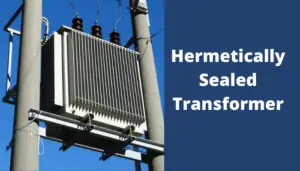Water kills electrical transformers, This is why we use moisture protection like transformer breathers and Nitrogen blankets.
In this article, let’s go into deep detail to discover everything about moisture in transformer oil. I made a deep search about this topic, And I will answer the important question that I found.
Can Transformers Get Wet, and Why?
Yes, transformers can get wet, One of the largest transformers in my work was too hot, By doing deep analysis and investigating, we discovered that the oil has water, But how did this water get into the oil tank? Moisture can enter the transformer tank from the outside environment as follows:
- Through the breather, during the breathing-in process, if the silica gel is not fresh.
- Also, if the transformer has any other holes or openings, then moisture can enter through.
- During oil replacement, if the new oil has moisture contaminates.
While the amount of moisture in a transformer depends on many factors, and can only be detected through oil testing and analysis.
Moisture isn’t always in the oil, it also can hide well in the other insulation between coils and the core. Where exactly? Let’s find out that.
Where Does Exactly Moisture Stay?
A transformer has two insulation types, one is solid and the other is liquid. For solid insulation, plant cellulose is used which originally contains around 5 percent of water, and undergoes a certain drying process to bring this level down to less than 1 percent.
For liquid insulation, which surrounds the solid insulating material, oil is used because of its better cooling and insulating properties.
The water content in the insulation keeps changing in both these insulators throughout the transformer’s lifetime, based on the temperature and external moisture.
In normal cases, most of the water remains in the solid insulation, but when the temperature rises from its base value, water starts flowing from cellulose to oil.
The state of solubility of water in oil largely depends on temperature. Data suggests that at 10 degrees Celsius, water solubility remains at 36 ppm, which could go up to 600 ppm at 90 degrees Celsius.
How Moisture Reduces The Life of Transformers?
If a transformer, such as a power transformer, gets wet, it can lead to various problems and potentially cause damage. Here are some potential consequences:
-
Short Circuits: Water is a conductor of electricity, and if it enters the transformer, it can create short circuits. This can lead to malfunctions, equipment damage, and even fires.
-
Corrosion: The presence of water can lead to corrosion of the transformer’s components. Corrosion can degrade the integrity of the transformer over time, affecting its performance and lifespan.
-
Insulation Breakdown: Transformers rely on insulation to prevent the flow of electrical current between different parts. Water can compromise the insulation, leading to breakdowns and a loss of electrical isolation.
-
Reduced Efficiency: Moisture can affect the efficiency of the transformer by altering the electrical properties of the insulation materials. This can result in increased losses and reduced overall performance.
-
Mechanical Damage: Water can also cause mechanical damage to the transformer, especially if it gets into moving parts. This can lead to issues with the mechanical operation of the transformer.
Exposure to water can have serious consequences for transformers, and precautions are usually taken to protect them from moisture.
Transformers are typically housed in sealed enclosures or equipped with protective measures to prevent water ingress.
If a transformer does get wet, it should be thoroughly inspected, and any necessary repairs or replacements should be carried out by qualified professionals.
How to Protect Transformer Oil From Moisture?
Protecting transformer oil from moisture is crucial to maintaining the insulation properties of the oil and ensuring the proper functioning of the transformer. Here are some measures to protect transformer oil from moisture:
-
Sealed Containers:
- Ensure that the transformer is housed in a sealed enclosure or container. This helps prevent moisture from entering the transformer and coming into contact with the oil.
-
Desiccants:
- Use desiccants or moisture-absorbing materials inside the transformer. Desiccants, such as silica gel, can be placed inside the transformer to absorb any moisture that may be present.
-
Breather System:
- Install a breather system on the transformer. A breather is a device that allows air to enter the transformer as oil levels change but filters out moisture and particulate matter. Regularly check and replace the desiccant in the breather.
-
Gaskets and Seals:
- Ensure that the gaskets and seals on the transformer are in good condition. Replace any damaged gaskets or seals to maintain a tight seal and prevent moisture ingress.
-
Regular Inspections:
- Conduct regular inspections of the transformer and its surroundings. Look for signs of water leakage, and address any issues promptly.
-
Drying Procedures:
- If the transformer has been exposed to moisture, it may be necessary to perform drying procedures. This can involve heating the oil to remove moisture. However, this should be done cautiously to avoid thermal stress on the transformer.
-
Proper Storage:
- If storing transformer oil, make sure it is stored in sealed containers in a dry environment. Avoid storing oil drums directly on the ground, as this can expose them to moisture.
-
Humidity Control:
- Control the humidity in the area where the transformer is located. Installing dehumidifiers or maintaining a controlled environment can help prevent the absorption of moisture.
-
Oil Sampling and Testing:
- Regularly sample and test the transformer oil to check for moisture content. This can help identify any issues early on and allow for corrective action.
-
Education and Training:
- Ensure that personnel responsible for transformers are educated about the importance of moisture control and trained in proper maintenance procedures.
It’s important to note that moisture control is just one aspect of transformer maintenance. Regular inspections, testing, and adherence to manufacturer recommendations are essential to ensure the long-term reliability and performance of transformers.
Always follow safety guidelines and consult with experts when performing maintenance activities on transformers.
how to remove moisture from transformer oil
Removing moisture from transformer oil is a critical step in maintaining the dielectric properties of the oil and the overall performance of the transformer. Here are some methods commonly used to remove moisture from transformer oil:
-
Vacuum Dehydration:
- This is one of the most common methods. The transformer is placed under vacuum, and as the pressure decreases, moisture within the oil vaporizes at a lower temperature. The vapor is then extracted, leaving behind drier oil.
-
Heating and Filtration:
- Heat the transformer oil to a temperature where moisture evaporates. The heated oil is then passed through a series of filters to remove both moisture and any impurities. Care should be taken not to overheat the oil, as excessive temperatures can degrade the oil and affect its properties.
-
Centrifugation:
- Centrifugal separation is another method. In this process, the transformer oil is spun at high speeds in a centrifuge, and the moisture, being heavier than the oil, is separated and collected.
-
Adsorption:
- Adsorption materials, such as activated alumina or silica gel, can be used to remove moisture from transformer oil. The oil is passed through a bed of adsorbent material, which captures the moisture.
-
Chemical Additives:
- Certain chemical additives can be added to the transformer oil to enhance its moisture removal properties. These additives can either absorb moisture or chemically react with it, facilitating its removal during routine processing.
-
Dry Air or Nitrogen Blanketing:
- Purging the transformer with dry air or nitrogen can help remove moisture. This involves circulating dry gas through the transformer, displacing the moist air, and reducing the moisture content in the oil.
-
Drying Filters:
- Install drying filters in the oil circulation system. These filters are designed to adsorb and remove moisture as the oil passes through them.
-
Reconditioning Units:
- Specialized reconditioning units are available that combine various techniques, such as heating, vacuum dehydration, and filtration, to effectively remove moisture and impurities from transformer oil.
It’s important to note that the choice of method depends on factors such as the level of moisture contamination, the condition of the transformer, and the specific requirements of the transformer oil.
Additionally, any maintenance or dehydration process should be conducted in accordance with manufacturer recommendations and industry standards.
Always exercise caution when working with transformers, and consider consulting with experts or professionals experienced in transformer maintenance and oil processing.
Methods to Discover Water in Transformer Oil
Initially, the water gets absorbed by the cellulose insulation, and with the increase in temperature, the moisture continues to flow in the oil.
Therefore, regular testing and monitoring is a way to protect transformer oil from moisture. For measuring the water content in the transformer, either of the two methods can be used i.e. drew point analysis and water in-oil analysis.
- Drew Point analysis: This method measures the saturation point of the air and assesses the dew point temperature. The dew point temperature actually determines the threshold and air needs to be cooled at this point under a constant level of pressure. By achieving this point, the air will no longer be able to absorb any more water in the form of gas.
- Water-in-oil analysis: This method actually detects the amount of water in oil by various methods. “Karl Fischer Coulometric Titration” method is the most popular one and measures the amount of iodine required for titration of the oil sample. Another method is the “Visual crackle test”, which is very subjective and can’t determine the actual quantity of water.
Once the detection of water is done, any of the two methods i.e. Hot Oil flush and Hot oil spray can be used to dry the transformer.
In the Hot Oil Flush treatment, the hot oil is pressed through a filter made of paper elements. That filter is sprayed on the transformer coil, which absorbs any kind of moisture from the coil assembly.
In comparison to that, the hot oil spray method involves spraying hot oil on insulation and sucking up the air surrounding the insulation.
Heat present in hot oil causes water to evaporate, which is collected by the suction of a vacuum. While the Hot oil spray method is more popular, the Hot oil flush method is easy and can remove a great amount of moisture from the transformer.


